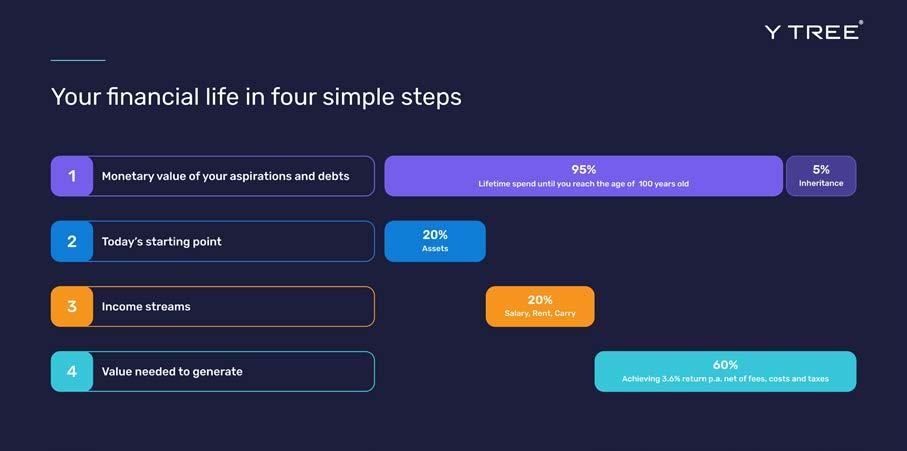
5 minute read
HOW TO RUN YOUR FINANCIAL LIFE LIKE AN INSTITUTIONAL INVESTOR
It’s fair to say institutional investors have some advantages over the rest of us.
They have rigorous efficiency, organisational depth, structure, transparency, scale, a strong process, governance, regulatory scrutiny, data, technology and a vast pool of human and intellectual capital - a list that might seem completely out of reach for individuals.
Let’s define first what we mean by an institutional investor in this instance. When we talk about institutions, we mean big endowments (like Harvard and Yale), pension funds and some of the largest family offices, not wealth managers, private banks, asset managers or IFAs.
These institutions have significant amounts of data and technology at their fingertips, plus a broad bench of human expertise to manage money effectively. It’s this combination that helps optimise returns and unlock value to meet both short- and long-term objectives.
But how does that institutional rigour translate into managing not just one pot of money, but lots; not just one source of income, but many; not just one investment objective, but multiple personal objectives? This is where we’re seeing technology come into play, with some of the practices, processes and thinking used across the world’s leading institutions increasingly being adopted in the sphere of personal wealth.
Asset Liability Modelling
It starts with a rather sexy principle called asset liability modelling (ALM).
Institutional investors are always balancing assets with liabilities. They manage the gap between the two and constantly assess whether they have the enough assets to safely fund their short-, medium- and longterm liabilities. This gap is often measured by the ratio of assets over liabilities, also known as the funding ratio. Institutional investors seek to have a funding ratio of more than 1, which means there is always something in the pot to fund your liabilities should they be required. In an ideal world, this score should be a little over 100. That way, you have more than you need in case something goes wrong in the future.
The starting point of any advice should always be what you want to do with your life and what you and your family will spend in the future - your liabilitiesrather than investment returns. Essentially, finding the ideal funding ratio and devising and implementing a financial life strategy to fill the gap.
But these calculations are not a manual process. It takes an engine to help us do this for diverse individual circumstances, at scale. Combining knowledge from the fields of computer science, statistics and applied mathematics, the principle of ALM can solve the most complex financial problems. Using technology, it’s now accessible and, more importantly, understandable to everyone.
Of course, we can’t predict what’s going to happen in the future, but we can plan for the worst. By leveraging statistics and big data, it’s possible to model how interest rates, inflation, economic downturns and all the rest can impact your current assets and, crucially, your liabilities.

To run your financial life like an institutional investor requires a change in mindset. The question is no longer plainly, “how do I maximise my returns?” But “how can my finances support my aspirations for my life, for my family and for generations to come?”
Efficiency
Sophisticated institutional investors never overlook the power of efficiency. Multiple, marginal gains across risk mix, liquidity, currency, cost and structuring compound to significant value over time.
When you are at the top of the league, every basis point counts.
THE WORLD’S BIGGEST INVESTORS CARE ABOUT THE SMALLEST FRACTIONS
Lower cost
Lowering the costs of your providers (including fund costs, discretionary fund management fees, custody, administration, foreign exchange and transaction costs) by 2% can save you the entire principal first invested when compounded over 20 years.
Reduce underperformance vs market
Investors should be receiving an appropriate level of return, after fees, for the risk being taken. This involves a shift in attitude. When the starting point of your investment strategy is returns, you’ll naturally seek out outperformance. Over the long-term, managers seldom outperform consistently. When you add fees and other costs into the mix, you’ll likely end up with average market return or less. The biggest determinant of long term performance is the risk taken by an investormuch more than the manager selection - and this risk can often be replicated using low-cost index tracker funds.
Risk
Investors should set a target risk level that is appropriate to generate the returns required to meet long term liabilities and life aspirations and then stress that risk against a number of scenarios (e.g. market falls, inflation, tax changes) to understand their capacity for loss. Once the target risk level has been set it should not change, unless circumstances change (e.g. spend targets, age etc.).
Currency
Investors should match the purchasing power of their assets against their currency of spend/liabilities. This means setting currency targets for a portfolio, in a similar way to setting risk targets.
Surplus cash reinvestment
Investors tend to hold too much cash, confusing cash and liquidity. By taking an institutional approach to liquidity management, investors should hold minimum cash to meet short term liabilities (a cash buffer). Technology feeds can show when cash inflows exceed that buffer and the excess should be invested automatically to avoid the opportunity cost of holding excess cash. Liquid investments can always be sold to generate cash required for liabilities.

Improved diversification
Multi-asset class portfolios can reap the benefits of diversification but looking through asset classes to “market exposures” is critical to understanding your risk level and risk mix.
Tax optimisation
The amount of tax you pay over a lifetime has a material impact on your wealth. We believe in making intelligent decisions about tax, informed by insight and experience, including making use of allowances, fitting risk in each tax wrapper to its tax profile, ensuring efficient account structure and ownership, as well as devising efficient accumulation or decumulation strategies.
Illiquidity budgeting

Private markets can provide exposure to market risks and access to higher returns than public markets through an illiquidity premium. Having an institutional process helps determine an appropriate long allocation and a budget for commitments to each vintage.
Dynamic risk level rebalancing
Institutional investors recognise how difficult it is to time markets and so do not attempt to time short-term market movements; instead they automatically rebalance their portfolios (unemotionally) back to their long-term target risk levels after positive or negative market performance.
Meaning
Implementing technology and data into wealth management practices will help make the process more appropriate, efficient and transparent, and ultimately build value. But what’s the point of all this process if it’s not life changing?

We really believe that money is only meaningful when it’s being spent on what matters most to individuals, families and communities.
The real wonder of an institutional process and greater efficiency is the extra wealth it generates. That extra wealth can be the difference that unlocks real change in society because it enables us to invest more deeply in our businesses, in philanthropy and in future generations. Managing your money effectively not only means you can enjoy the life you want to live, but it helps spread that wealth further, and for better.
Johnnie Hampel Co-Founder & Head of Client Relations, Y TRE










